
 The newsletter of the Radio JOVE Project
The newsletter of the Radio JOVE Project"Radio Astronomy Citizen Science and Outreach"

 The newsletter of the Radio JOVE Project
The newsletter of the Radio JOVE Project
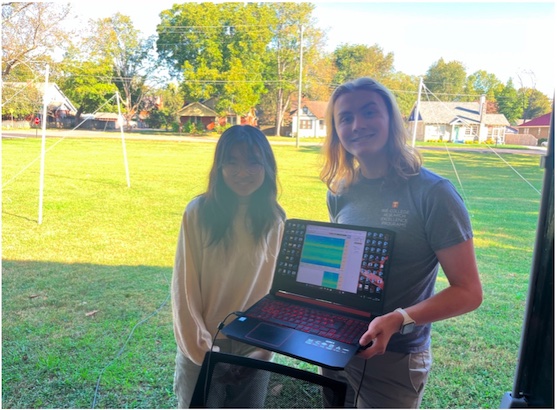
My name is Angel Hu. I’m 17 years old and a senior at Central Magnet School in Murfreesboro, TN, USA. I’ve been interested in astronomy for almost my entire life, and I hope to further my studies in college!
Over this past year, I have been working with Dr. Chuck Higgins of Middle Tennessee State University on my senior thesis project, which will compare Radio JOVE solar data from the annular eclipse in 2023 across different observing sites.
My own observing site, Central Magnet, is a part of the Sun Radio Interferometer Space Experiment (SunRISE) Ground Radio Lab, a citizen science project started by the University of Michigan and NASA’s Jet Propulsion Laboratory to observe solar events here on Earth. SunRISE uses the Radio JOVE dual-dipole antenna and SDRPlay receiver system to collect radio emissions from the Sun, Jupiter, and the Milky Way on Radio-Sky Spectrograph.
After receiving the Radio JOVE telescope kit, I worked with members of the Science National Honor Society club to set up the system in an open field at the back of the school. We learned a lot about teamwork, manual setup, radio instrumentation, software, and problem solving while doing trial runs with the data collection.
On the day of the eclipse, we collected data from around 9:00 AM CDT to around 3:00 PM CDT. Because it was only an annular eclipse, and Murfreesboro was not in the path of totality, we didn’t observe a huge drop in radio emissions; however, this was an amazing opportunity to observe the Sun and see the entire antenna-receiver system operate together.
A huge thank you to Dr. Higgins, SunRISE, and Central Magnet Science National Honor Society for making this project possible!
While researching for my master’s degree at UEFS (State University of Feira de Santana/Universidad Estatal de Feira de Santana, Bahia, Brazil), I acquired a Radio JOVE 1.0, which was a useful reference in my dissertation [1]. Now, with a Radio JOVE 2.0 station, I immediately thought about using it when invited to participate in a public event for science outreach, related to the 2023 Annular Solar Eclipse. It took place on October 13th, in Campina Grande (PB), with a short trip to see the eclipse on October 14th, in Lajedo de Pai Mateus. This place resembles an outback landscape with peculiar plants and rock formations. The conference at FIEP (Federation of Industries of Paraíba), Figure 1, it was organized by Alexey and the SBPC (Brazilian Society for Science Progress) [2].
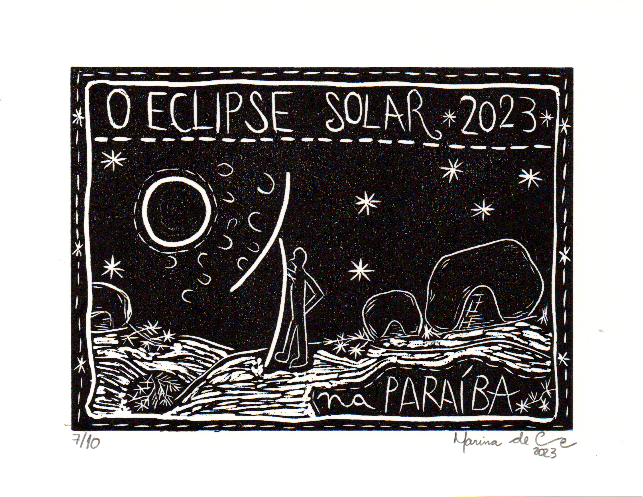
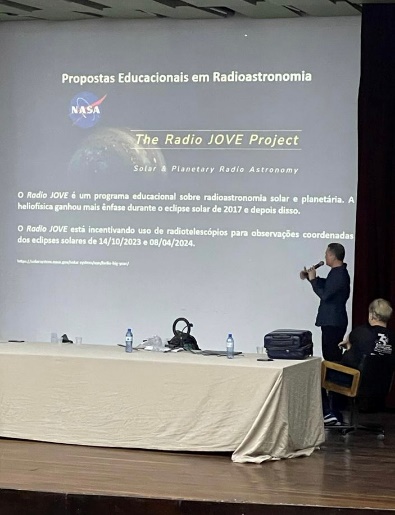
We explained some astronomical details, how the eclipse occurs, remembering its scientific relevance. As an example, in the small town of Sobral, Ceará, Brazil, during the total solar eclipse of 1919 [3], Charles Davidson and Andrew Crommelin photographed the Sun for the experiments by Frank Watson Dyson and Arthur Stanley Eddington about the General Relativity Theory. Keeping the due proportions, seeing an annular or total eclipse deserves our best efforts to be witnessed and understood. We also spoke to local TV channels and students. Right after the trip to Paraíba, I spoke briefly at UEFS about testing the Radio JOVE 2.0 station for monitoring the solar eclipse.
I attended the online Practice Sessions #1 to #4, and it was not possible to meet some of the requirements we talked about [4]. In particular, it was not possible for us carrying out long-term observations at the same place, before and after the eclipse, at Lajedo de Pai Mateus. We had to travel to the site just a few hours before the eclipse, and we had to leave just after sunset. Before the trip, I did tests with different antennas, in several places in Bahia, and I had to decide on one that I could take on the plane and then in a backpack to climb the hill, Figure 2.
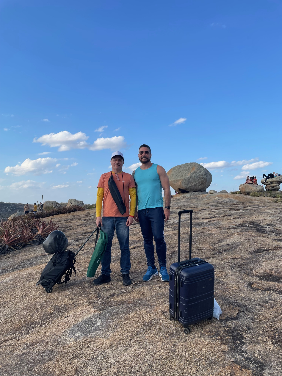
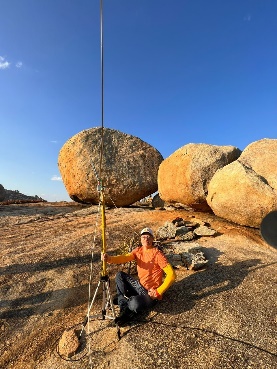
When we got in, dozens of people had already arrived at Lajedo de Pai Mateus to witness the phenomenon. Being there for the first time, I would have to quickly decide: where to install and stabilize the antenna; where to set up and put the computer, coaxial cable etc., taking care of the local environment, and enjoying the spectacular view. The antenna, on a support almost 2.4 m high (8 feet), was knocked down a couple of times by the wind, being difficult to stabilize it on the rocks with the ropes. I decided to reduce the mast height and stay holding it while the laptop recorded the data, Figure 2. The station was working with the RSP1A, SDRConsole, SDRc2RSS and the Radio-Sky Spectrograph, also Radio-Jupiter Pro. At our site, the ring of fire moment occurred from 19:45:45 to 19:47:18 UTC, minutes before the sun set. When the ring formed, people were delighted and many even clapped, it was a memorable experience, Figure 3.
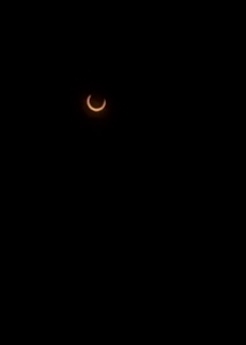
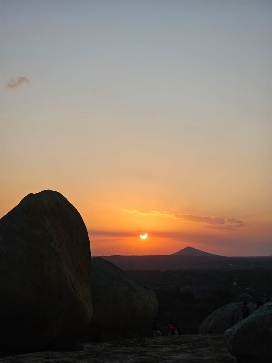
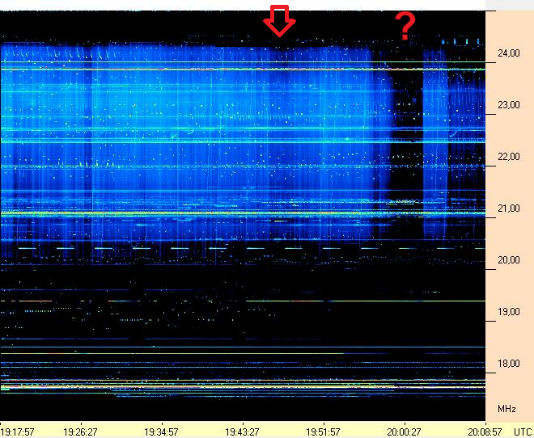
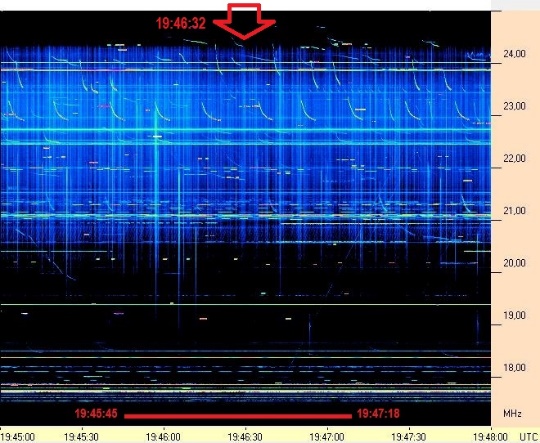
Analyzing the useful data saved, Figure 4, I noticed a slight drop in the spectrograph signal (red arrow), approximately at the annular time (19:46:32 UTC [5]). At the end of the record, about ten minutes later, there is a big drop in signal (red question mark). If these are really related to the eclipse, could the second effect be the Moon's shadow causing some sudden change in the Ionosphere? Could it be caused by the lunar umbra being so inclined over the atmosphere at the sunset on the observation site (as simulated in the Figure 5)? Unfortunately, the instabilities of the antenna mast do not allow to say this for sure.
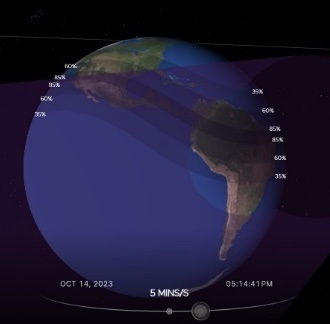
There was also some hope of recording a Type III solar emission. However, analysis of the Spectrograph file and subsequent data from NOAA page [6] did not record anything for that day and time. After all this experience, I suggest for the 2024 total solar eclipse, it may be interesting to carry out some observation in a similar configuration to the one I did. In a place where the eclipsed Sun is also close to setting. It is an idea to study whether the lunar shadow in the final moments of the eclipse, tilted over a considerable part of the ionosphere, as illustrated in Figure 5, affects radio propagation in an unusual way. The overall result of our experience was positive, the SBPC Conference mobilized people from the local community, to whom we talked about the Sun and radio astronomy, which always has the potential to reveal new knowledge. The data from the October 14th session is already loaded into the Radio JOVE Data Archive [7], as well as more details on the page about radio astronomy, in Portuguese [8].
Thanks to Germano P. Guedes and Marildo G. Pereira, Professors from the Department of Physics/UEFS.
References:
[1] ARAÚJO, Marcelo Lago. Simuladores experimentais de
radiotelescópios para o ensino de astronomia no nível médio: 2017:
http://tede2.uefs.br:8080/handle/tede/644.
[2] SBPC:
http://portal.sbpcnet.org.br/noticias/encontro-em-campina-grande-prepara-publico-para-eclipse-solar-de-14-de-outubro/
[3] Centenário do eclipse de Sobral:
http://portal.sbpcnet.org.br/livro/centenarioeclipsedesobral.pdf
[4] Radio JOVE 2023 Solar Eclipse Citizen Science Campaign:
https://radiojove.gsfc.nasa.gov/newsletters/2023Jun/index.html#3
[5] Time and date:
https://www.timeanddate.com/eclipse/map/2023-october-14
[6] NOAA, Solar and Geophysical Event Reports:
https://www.swpc.noaa.gov/products/solar-and-geophysical-event-reports
[7] Radio JOVE Data Archive: https://radiojove.net/archive.html
[8] https://www.radioastronomia.pro.br
By October 2023, there were 228 registered Radio JOVE users worldwide, ninety-nine of them located in North and South America. After many practice sessions, Radio JOVE led an observation campaign on 14 October 2023 for the annular solar eclipse over the Americas. The goal was to collect data to determine whether the lunar shadow significantly changed the transparency of the ionosphere at radio frequencies between 15 to 30 MHz. From the observers located in Alaska to Texas, in Pennsylvania to Florida, and in Mexico down to Brazil (see article in this issue), we had seventeen groups submit data via the Radio JOVE data archive or on the groups.io listserv. Our partnership with the SunRISE Ground Radio Lab (https://sunrise.umich.edu/ground-radio-lab) added three (of sixteen) high schools that collected eclipse data. We know many others made observations, but they have not yet submitted data to the archive. It’s not too late, please submit data here: https://radiojove.net/archive.html.
Data analyses are still ongoing, but preliminary data from Tom Ashcraft in Lamy, NM and Mary Johnston in Sonora, TX, both in the path of annularity, show a slight change in daytime interference during the time of the solar eclipse (see Tom’s data in the figure). Further analyses of the calibrations and statistics are needed to answer the question about radio wave propagation through the ionosphere. Either result, positive or negative, will be interesting. A positive confirmation of a change in the ionosphere will help us further understand ionospheric plasma density and variability, and a negative result will put limits on those values.
As promised, we will share our results with you when we have a more definitive answer. The 2023 eclipse was a great learning experience for most of us. We hope you are still willing and excited to make more observations for the 2024 total solar eclipse on 8 April 2024.

Interest in radio astronomy at the Cincinnati Astronomical Society was recently revived by a presentation on amateur radio astronomy delivered by one of our members, a physics and engineering instructor, at the May 2023 members meeting. One of the topics was Jupiter’s decametric radio emissions and the NASA Radio JOVE initiative. That raised enough interest to launch a Radio JOVE group in late August. It didn’t take long to learn that Radio JOVE wanted participants to collect solar data during the October 14th annular eclipse. We had no idea what we were getting ourselves into, but we accepted the challenge of building a fully-operational Radio JOVE installation in six weeks. We proposed to build a 10-ft high dual-dipole antenna at the far east end of CAS’ observing field, bury 30 feet of underground conduit for the antenna coax to an existing 30-ft conduit leading to one of our observatory buildings 60 feet to the west, and set up the SDR and computer in the building. The board of trustees unanimously approved the project.
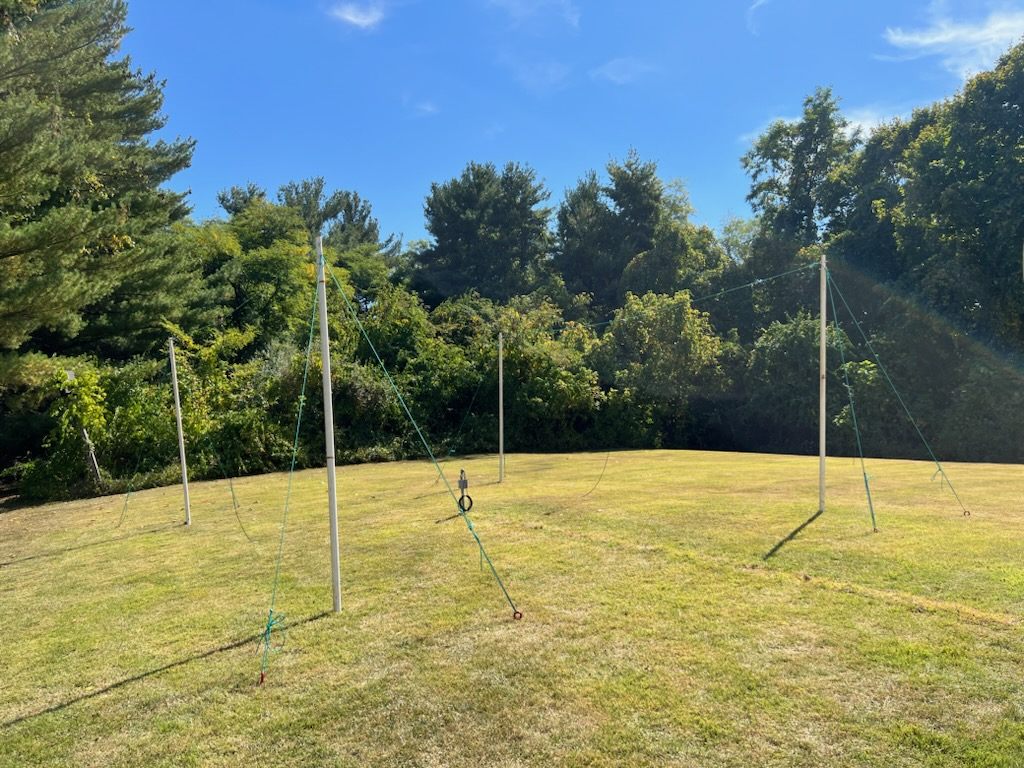
In retrospect, we led a charmed existence during those weeks. Our small but dedicated team pulled together to achieve the objective, and everything went right the first time. It was a truly great team-building and friendship-building experience. That’s what our venerable old Society is all about.
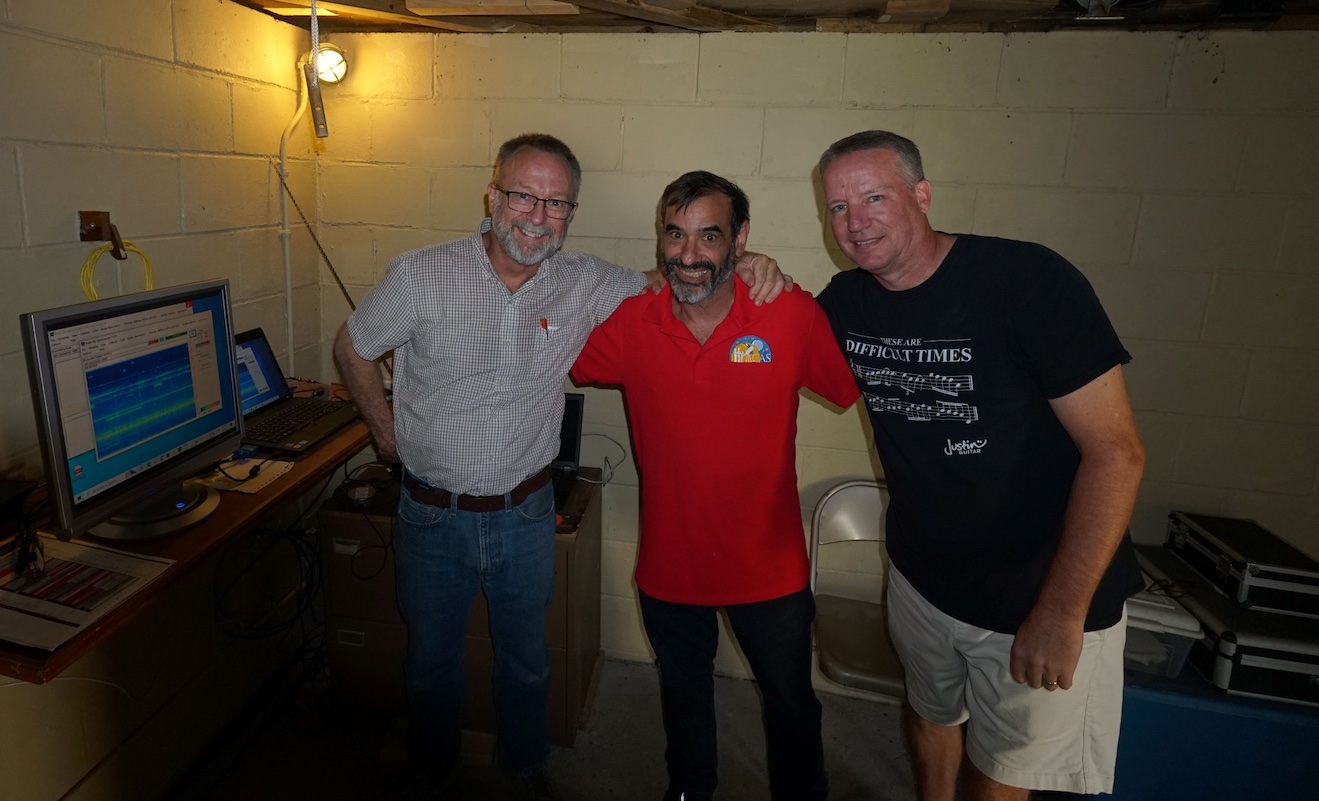
Our new Radio JOVE telescope went into operation for the first time on Saturday, September 30 (two weeks before the eclipse deadline). Within the first few minutes, at 11:46 EDT (15:46 UTC), we observed a Type III solar burst! The observation is shown below. We were delighted to see that the same burst was reported by other Radio JOVE observers in New Mexico, North Carolina, and Sonora (Mexico). We consider the observation to be first light on this instrument.
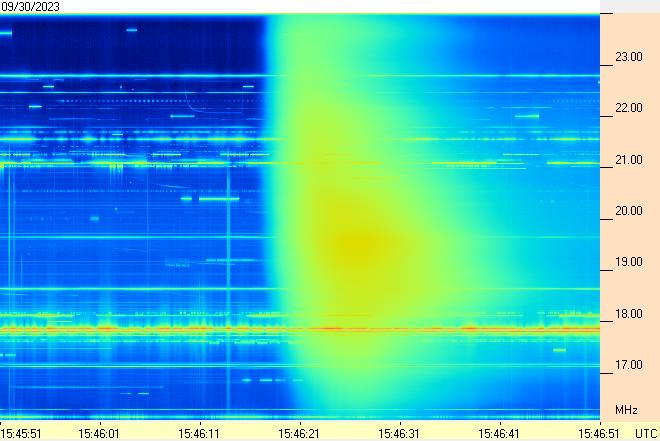
We have since installed a delay cable in the south dipole lead-in coax to “steer” the antenna down to the ecliptic, and are currently doing some antenna work and getting our arms around integrating Radio Sky Spectrograph with Radio-Jupiter Pro. Then we’ll be going after those fascinating Jupiter-Io decametric emissions. We’re looking forward to learning a lot and having a lot of fun doing it.
The Cincinnati Astronomical Society is one of America’s oldest and largest amateur astronomy organizations, founded in 1911 and comprised of over 300 members. We promote visual observing, astrophotography, citizen science, and (now!) radio astronomy, and actively engage in regional public outreach.
|
In Memoriam: Wes Greenman passed away on August 13, 2023 at the age of 82.
by Richard Flagg and Dave Typinski 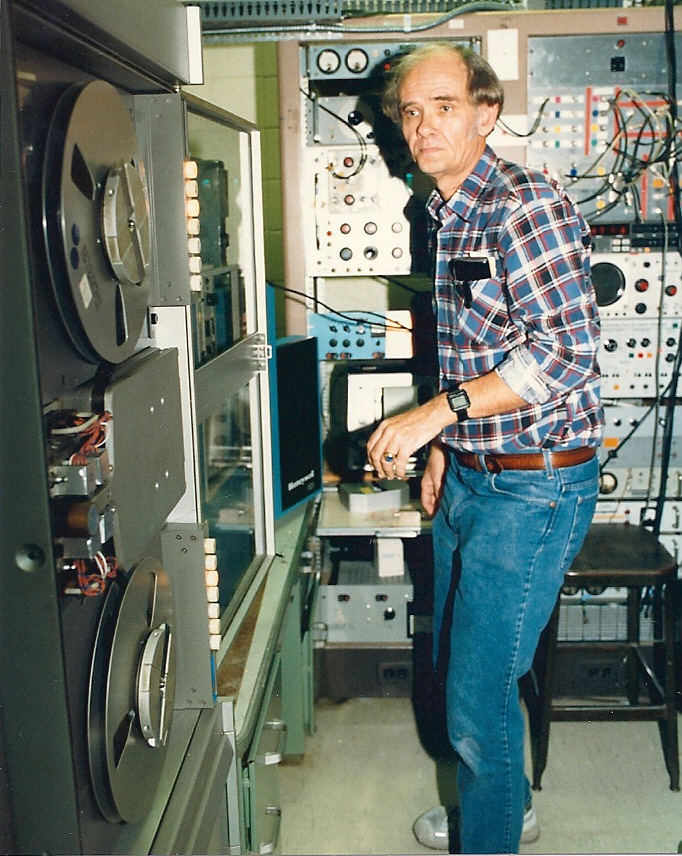
Wes was a member of the Radio JOVE team from its very beginning in 1999. He was involved with the design of the Radio JOVE dual dipole antenna and assembled parts for over 2000 RJ1.1 receiver kits. That’s over 100 components per kit that were ordered, sorted, bagged, and shipped – with each kit carefully checked to make sure the recipient would have all the parts required to succesfully assemble their Radio JOVE receiver. Wes operated his own Radio JOVE observatory in Alachua, Florida, providing valuable observation data to the Radio JOVE data archive and the Planetary Data System archive. Born in New York, Wes grew up in Miami and attended engineering school at the University of Florida. Soon after graduation he began his long career in the UF Astronomy Department which operated one of the premier facilities for observing radio emissions from the planet Jupiter. One of his main duties was maintenance of all the equipment at the radio observatories. This included all the antennas, receivers, recorders, calibration, and timing systems. During the early years, the observatory was located at Bivens Arm lake near the UF campus, but as the city expanded, the observatory was moved some 45 miles to a remote site in Dixie County, Florida. Wes was instrumental in establishing the new facility and assumed the task of installing new Yagi antennas and all the instrumentation. The multielement Yagi antennas were mounted atop telephone poles, so the antennas and drive mechanisms were accessed using an aerial bucket truck. One day Wes was starting the installation of a new Yagi antenna. It was always fun to run the bucket as fast as possible and as close as possible up the side of the pole. Wes was enjoying this activity when upon reaching the top of the pole he discovered a rattlesnake curled up on the very top, smiling at him. Engineer one, snake zero. In addition to tending all the observatory systems, Wes was engaged in helping to build a huge 640 dipole antenna array. It’s hard to calculate how many miles were driven traveling from Gainesville to Dixie over the years but at one point Wes noted that he had driven at least as far as to the moon. For ten years Wes participated in the annual public outreach Starry Night event held at the Florida Museum of Natural History. His coworkers knew him as an overwhelmingly kind, helpful, and just an all around nice guy. Wes loved playing slowed-down S bursts for people and explaining the basics of Jovian emission and solar bursts to anyone who expressed an interest. He was a wonderful missionary for the Radio JOVE program. Wes never lost his sense of wonder. He was always intensely curious about pretty much everything. But Jupiter radio emission, that really had him hooked. He was always excited to see yet another group of S bursts or an N event, even after he'd seen five decades of them. He simply loved radio observing. But not only strip charts and spectrograms. Wes loved to listen to Jupiter. It was music to his ears. He enjoyed building hardware, constructing countless pre-built receiver kits for the Radio JOVE program. Wes loved his cats as much as radio astronomy. He often asked the rhetorical question, "How could you ever trust someone who doesn't like cats ?" This goes a long way to explaining Wes as a person. Wes was a very smart yet very humble man who was kind to absolutely everyone and everything. Wes taught us all a lot about many things. His decades of experience building and maintaining instrumentation and antenna systems for the UF radio observatories were an unparalleled source of invaluable information, all freely and cheerfully given, simply for the asking. His hard and careful work over the years guaranteed quality data for numerous Masters and Doctoral candidates at UF. Wes’s dedication to the Radio JOVE program made it possible for hundreds of new observers to experience the thrill of hearing radio signals from Jupiter and the sun with equipment they themselves were able to build and operate. Those of us who were fortunate enough to know and work with Wes will miss and remember him each and every night as we look up into the sky and see Jupiter shining brightly among the many stars. 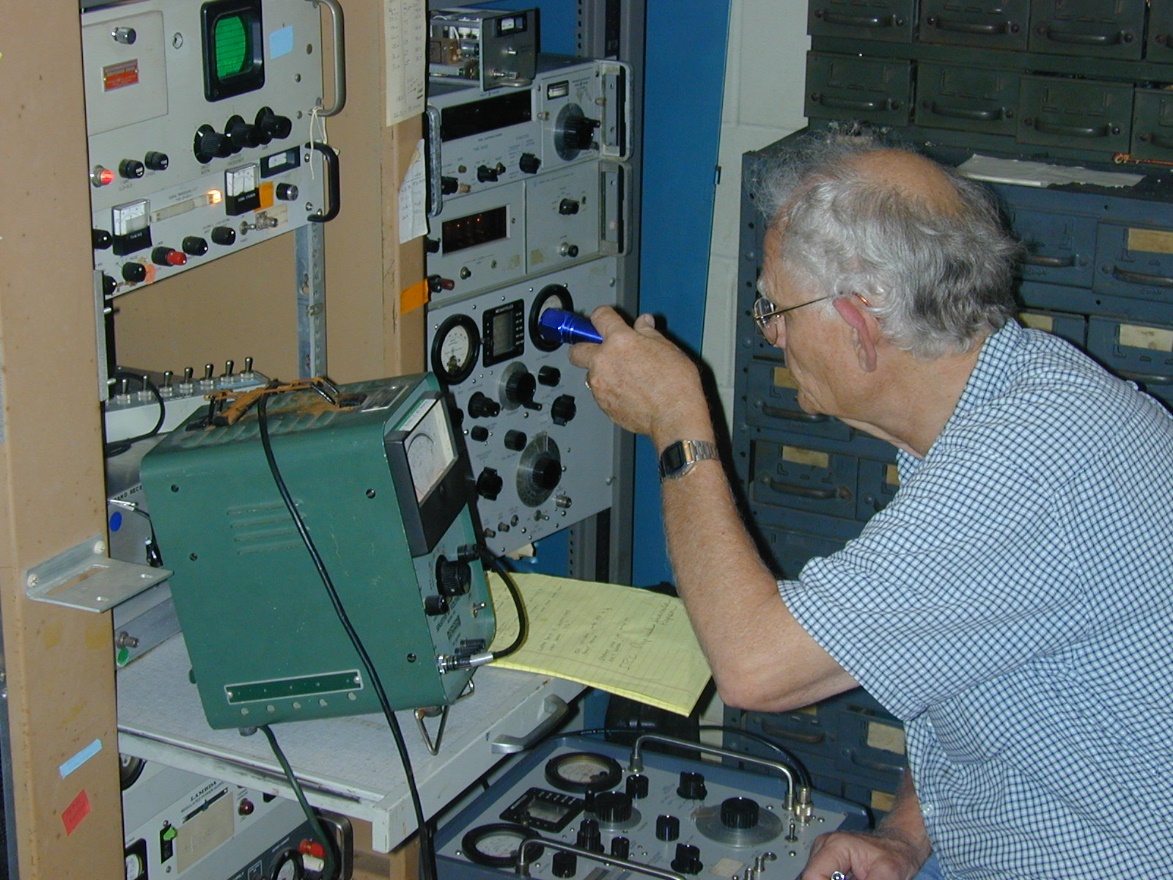
|
What is the minimum 20 MHz antenna temperature one should observe assuming:
Short answer: 25 kK at 20 MHz.
Long answer: it depends on
1) The Galactic background (GB) emission is randomly polarized with a brightness temperature that is lower at higher frequencies and higher at lower frequencies. It's nearly 8 dB colder at 30 MHz (18 kK) than it is at 15 MHz (104 kK). However, at very low frequencies, around 3 MHz, there is a turnover of the GB spectrum. Below 3 MHz, the temperature decreases with decreasing radio frequency.
Brightness temperature is a measure of emission source noise power at a given radio frequency summed over all polarizations. In contrast, antenna temperature is a measure of the noise power intercepted by an antenna at a given radio frequency. Any antenna, linear or circular polarized, can receive only half of the GB's randomly polarized emission. A single half-wave 20 MHz dipole antenna with its beam aimed toward the north galactic pole thus has a minimum antenna temperature of 25 kK.
That fact has tripped up your author for a long time and bears repeating: brightness temperatures reported in the literature are given in terms of total emission, not in terms of what a particular antenna can observe. For randomly polarized emission such as the GB, one can measure only half of it because no antenna can see 100% of randomly polarized emission, rather only 50% of the emission.
2) A diurnal variation in the GB temperature occurs as the antenna beam sweeps across the plane of the galaxy. Compared to the galactic poles, the galactic plane is very hot in terms of noise temperature.
3) Because the angular size of the galactic plane is very narrow compared to the vast angular size of the galactic polar regions, the magnitude of the diurnal variation depends on the antenna's beam size. Smaller beams (higher directivity) see a greater variation than large beams (lower directivity).
4) The amount of diurnal variation in the GB also depends on the time of day when the galactic plane sweeps through the antenna beam -- which in turn depends on the time of year. That is, it depends on Earth's position in its orbit around the Sun. The increase in observed GB as the plane of the galaxy passes through the beam is larger when that happens at night (roughly 2 to 3 dB when observed with the Jove array) than it is when that happens during the day (more or less unnoticeable when observed with the Radio JOVE array during solar max). That's because the daytime ionosphere attenuates the GB emission and daytime band noise contributes to the noise being observed; both effects wash out the desired signal.
5) The degree to which the daytime ionosphere attenuates the GB depends on average solar activity -- e.g., whether the Sun is at solar maximum or solar minimum in its roughly 11-year cycle. This can be thought of in terms of terrestrial propagation via ionospheric reflection, but from the space-side of the ionosphere. The ionosphere reflects terrestrial signals back down to Earth, but it also reflects cosmic emission back out into space. If it does one of those efficiently (solar max means good upper HF band DX conditions for ham radio), it will do the other efficiently too (solar max means seeing less of the galactic plane's emission at ground level during the daytime).
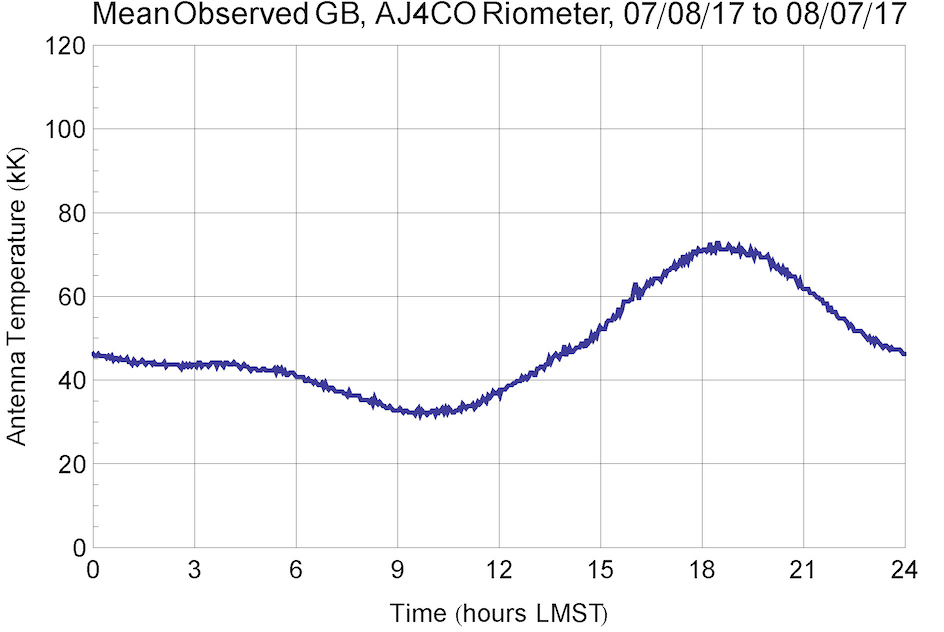
References:
https://www.aj4co.org/Publications/The%20Quiet%20Day%20Curve,%20Typinski%20(SARAJ,%202017).pdf
https://aj4co.org/Calculators/Frequency_to_Galactic_Background.html
https://www.aj4co.org/Publications/The%20Galactic%20Background%20in%20the%20Upper%20HF%20Band,%20Typinski%20(SARAJ,%202013).pdf
https://aj4co.org/Publications/Things%20That%20Go%20Hump%20in%20the%20Night%20-%20A%20Fun%20Experiment,%20Typinski%20(RJB,%202015).pdf
See Plot 2, page 8:
https://www.aj4co.org/Publications/TFD%20Element%20Efficiency%20Analysis,%20Typinski%20(TRA,%202020).pdf
Radio JOVE has partnered with the SunRISE Ground Radio Lab (https://sunrise.umich.edu/ground-radio-lab) to make a set of twenty-two Training Modules to help participants learn more about radio astronomy, solar and Jupiter science, radio telescope operation, and the methods of citizen science. You can find all the modules here: https://radiojove.gsfc.nasa.gov/citizen_science/training.php.
These modules are meant to be self-paced guides to help beginner and intermediate participants become more knowledgeable in radio science and to advance their skills in radio telescope operation and observations. We want every participant to be able to submit the highest quality data possible to the data archive. Each module contains prerequisites and learning objectives to help you get started and to move forward. Coming soon we will add follow-up questions to test your knowledge and submit feedback.
Speaking of feedback, please feel free to send us comments, criticisms, and suggestions for improvement. This is the first edition of these modules, and we hope to add and improve them going forward. Happy learning!
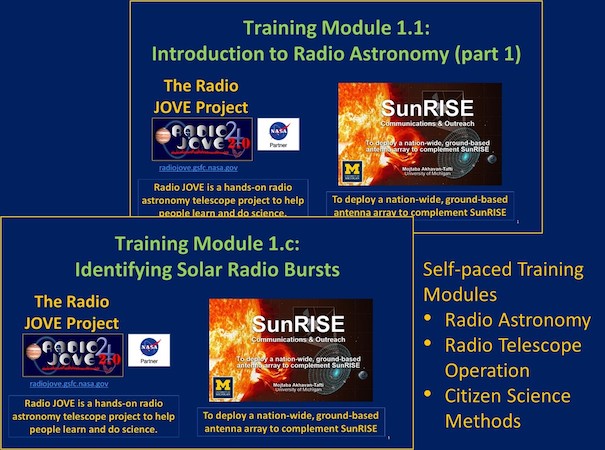
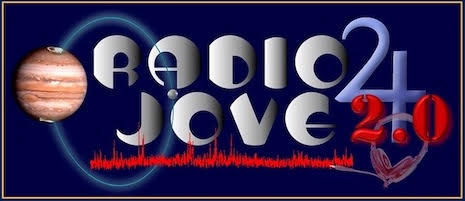
The JOVE Bulletin is published twice a year. It is a free service of the Radio JOVE Project. We hope you will find it of value. Back issues are available on the Radio JOVE Project Web site, http://radiojove.gsfc.nasa.gov/
For assistance or information send inquiries to:
or
